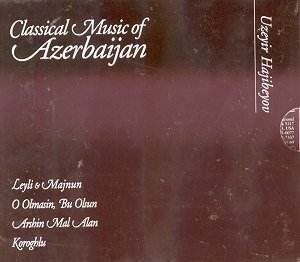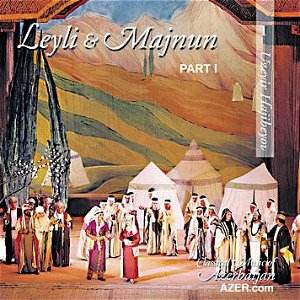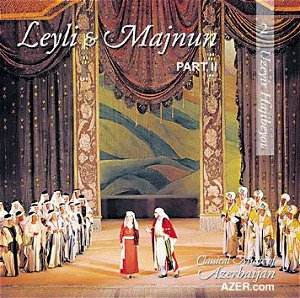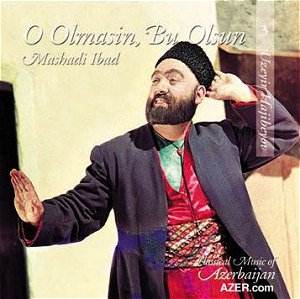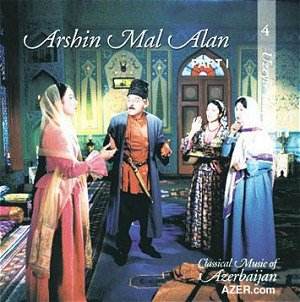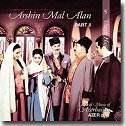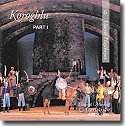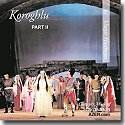It is the retreat of those bemused by the flood
of music from almost every country to dismiss works as ‘local’,
‘parochial, ‘primitive’, ‘insular’ or the old lie (often told
against Vaughan Williams’ music before Previn, Slatkin and Haitink)
that ‘this is music that simply doesn’t travel!’ It is comforting
for those who pretend to omniscience to clear the field in this
way and concentrate on the known - the reassuring, the multiply
recorded, the already documented.
Azerbaijan was one of the Soviet Socialist Republics
before Perestroika simultaneously liberated and cast adrift. During
its time under Soviet suzerainty its composers attended Russian
conservatoires and the state recording company Melodiya did some
recordings of local classical talent. The Melodiya legacy is largely
an analogue one - in LPs and 78s. Its tenure on the catalogue
is fragile.
This set was issued in 2001 and was produced
courtesy of Azerbaijan International and Statoil of Norway. I
was disappointed that the dates and locations of the original
recording sessions were not given. It would have been good, from
a discographical point of view, to have had the original Melodiya
set numbers for each opera.
Uzeyir Hajibeyov lived in lifelong fear knowing
that his brother Jeyhun (1891-1962), living in Paris, was writing
against communism. When the Soviets took Azerbaijan, Uzeyir was
on the list of people who were to be liquidated. His life was
spared though he was dismissed from the conservatory. Gliere (1875-1956)
was imported to Baku and there wrote his opera Shakh-Senem
in Baku in 1934. However Hajibeyov's style rose triumphant, echoed
to varying degrees in the work of Gara Garayev (1918-1982), Fikrat
Amirov (1922-1984), and Tofig Guliyev (1917-2000). During the
Stalinist 1930s Hajibeyov was again on the hit-list. It was 1937
and there was to be a celebration of Azerbaijani art in Moscow.
Hajibeyov had just completed his opera Koroghlu (1932-1937).
Stalin had somehow heard Hajibeyov’s opera Arshin Mal Alan
which he liked very much. Koroghlu was accordingly
chosen to go to Moscow and Hajibeyov enjoyed considerable éclat
being made Soviet People's Artist as well as receiving The Lenin
Order; the highest Soviet honour for a musician. He laid out the
values of Azerbaijani music in the book, "The Principles of Azerbaijan
Folk Music", 1945. Those principles had no place for atonality
nor will you find any here.
Leyli and Majnun is surprisingly
like Rossini blended with the Polovtsian music from Borodin’s
Prince Igor. The music proceeds in a series of statuesque
tableaux with the singers sounding as if the style is ‘stand and
deliver’. The work has plenty of vitality and bounce not least
in the nationalist choruses. The mood is often set by a swaying
Mid-Eastern movement. Local colour is provided by a balalaika
sounding like the Azerbaijani tar and by muezzin-like calls. In
Act 4 (tr.3) there is a striking tabla-like drumbeat. An ululating
female voice can be heard at the end of scene 1 of Act V rather
like similar effects in Peggy Glanville-Hicks’ cycle Letters
from Morocco. Act IV is stormy taking a leaf from Verdi’s
Macbeth. Technical defects, which are few, include some
passing distortion on the choral side (tr. 2 25.52).
O Olmasin, Bu Olsun is very forwardly
recorded for radio in 1953. It sounds just a little wheezy with
dated but gripping sound. Rather a pity that the work is presented
in a single massive track. This is a light buffo piece
in which an old man’s lechery is frustrated. It is more music-hall
than opera house. Parallels in English music might be The Arcadians
or Tantivy Towers. There is some sparing use of the
tar at 47.02. Other local colour comes in the form of a shindig
of street pipes and, towards the end of the work, rhythmic clapping.
There are spoken Azeri links between the musical setpieces. It
sounds like knockabout stuff with more romantic moments such as
the serenade at 19.11.
Arshin Mal Alan was and is a well-loved
work in Azerbaijan. The last opera presented in Baku before the
Bolsheviks took the city in 1920, it is a lively piece interspersed
with spoken tracks. The music can be expressive in a western way
(tr.9) and there are many fine songs here. Tracks 11 and 13 are
lyrical show-stoppers sung by Nazakat Ammamdora. The glistening
Rimskian instrumental tapestry has richness [15] as well as plunging
rhythmic life [21]. In the CD5 at tr. 8 Hajibeyov shows imaginative
reach where he allows the touching power of the spoken word to
be contrasted with the high violins in Pelléas-like
writing. Another impressive example is the marmoreal song for
Golchohra at tr.14 with its gong-stroke underpinning. Gulchohra
also has a touching serenade at tr.11 rising to a passionate trio
for her with Asya and Telli. At tr.15 Asgar sings with sly lyricism.
There are several purely orchestral interludes of which the wild
one at tr. 19 is well worth sampling. From time to time tabla-like
drums are used. The finale vanquishes all doubts: high on pathos
and sentiment. This makes a well-weighed Hollywood style sign-off.
Koroghlu is reckoned to be the
pinnacle of Hajibeyov’s operatic output. Its triumph is in the
meeting of the mid-eastern slip and slide of phrasing with a glaring
Tchaikovskian lyricism. The tar also puts in an appearance from
time to time. There is fervent nationalist choral writing and
a Mussorgskian air of freedom, independence and resolute defiance;
not just conviction but ferocity. Think in terms of the choral
singing in Glinka’s Ruslan and Ludmilla and A Life for
the Tsar. The first part of Act II is louringly Beethovenian
- perhaps resembling Tanayev (tr.4). Tr.6 Act III is titled At
Chanlibel. This uses ragged grand fanfares and the creates
a sense of luxurious palanquins amid the skirl and sway. Tr.1
of CD7 has the shouts of the chorus and the stentor of Koroghlu
himself sung with blazing presence by Lutfiyar Imanov. Tr.2 Act
IV starts with a decidedly orchestral twang. Strangely the song
at the start of Act IV sounds like the ostinato from the finale
of the Sibelius Violin Concerto. Act V is sinister and apocalyptic.
I noticed the merest hint of shredding distortion on the choral
singing. When the gloom gives way to celebration shrill woodwind
careen up and down the orchestral canvas like the Auvergnat pipe
and tabor in the Canteloube songs but wilder … irrepressible.
The piece ends in blazing temples of choral tone. This is sturdy
historic costume drama. If you like Madetoja’s Pohjalaisa or
the later operas of Smetana you will enjoy Koroghlu although
its melodic invention is second to Arshin Mal Alan.
The very full notes are in both English and Azeri.
Oddly enough there was no sign of Azeri translations in the six-CD
Azerbaijani Classical Music album also reviewed on this site.
Plot synopses are given but no libretto. These can be found in
both English and Azeri Latin on www.hajibeyov.com.
Rob Barnett
FURTHER BACKGROUND
www.hajibeyov.com
http://www.azer.com/aiweb/categories/magazine/52_folder/52_articles/52_music.html
http://www.culture.az:8101/theatres/opera/deyat/deyat_e.htm#fami
